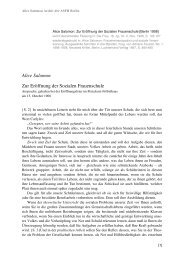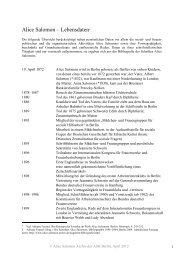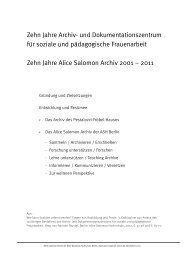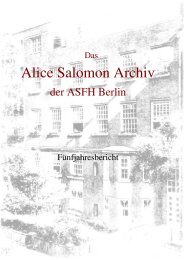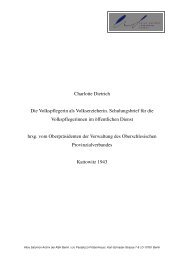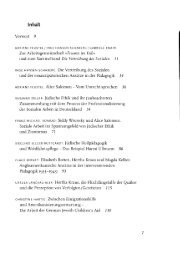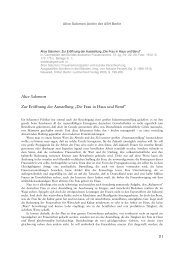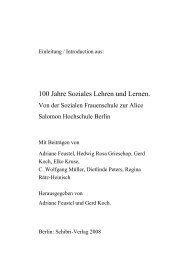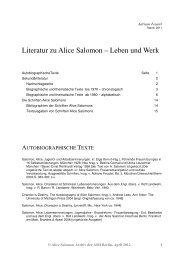100 Jahre Soziales Lehren und Lernen. - Alice Salomon Archiv
100 Jahre Soziales Lehren und Lernen. - Alice Salomon Archiv
100 Jahre Soziales Lehren und Lernen. - Alice Salomon Archiv
Create successful ePaper yourself
Turn your PDF publications into a flip-book with our unique Google optimized e-Paper software.
Einleitung / Introduction aus:<br />
<strong>100</strong> <strong>Jahre</strong> <strong>Soziales</strong> <strong>Lehren</strong> <strong>und</strong> <strong>Lernen</strong>.<br />
Von der Sozialen Frauenschule zur <strong>Alice</strong><br />
<strong>Salomon</strong> Hochschule Berlin<br />
Mit Beiträgen von<br />
Adriane Feustel, Hedwig Rosa Griesehop, Gerd<br />
Koch, Elke Kruse,<br />
C. Wolfgang Müller, Dietlinde Peters, Regina<br />
Rätz-Heinisch<br />
Herausgegeben von<br />
Adriane Feustel <strong>und</strong> Gerd Koch.<br />
Berlin: Schibri-Verlag 2008
22 Adriane Feustel, Gerd Koch<br />
Adriane Feustel, Gerd Koch<br />
Introduction: From the Social Women′s School to the<br />
<strong>Alice</strong> <strong>Salomon</strong> Hochschule Berlin<br />
Following a 15 years experimental and pilot phase, in 1908 the first interdenominational<br />
school was fo<strong>und</strong>ed in Germany with a two-years training for female social workers: the Social<br />
Women‘s School, today the <strong>Alice</strong> <strong>Salomon</strong> Hochschule Berlin. If the time since 1899 is<br />
counted when the first one-year training courses were set up, the school is among the world‘s<br />
oldest schools for social work alongside the School voor Maatschappelijk Werk in Amsterdam<br />
and the New York School of Philanthropy (now the Columbia University School of<br />
Social Work). This laid the fo<strong>und</strong>ations for training which have proved so<strong>und</strong> right up to the<br />
present day: a scientific basis, interdisciplinarity, close links between theory and practice, international<br />
orientation and interdenominationalism. And these fo<strong>und</strong>ations are still in place<br />
today despite the rapid developments in the training due to Europeanization, diversification<br />
and specialization in the Masters courses. Even though these fo<strong>und</strong>ations have not always<br />
been equally recognised and respected, they have contributed to the fact that the school has<br />
always enjoyed a good reputation and to the <strong>und</strong>isputed quality of the training – although it<br />
was regarded as highly contentious at times, for example in the 1970s.<br />
A look at history can stem from different motivations and, depending on the perspective, can<br />
produce different results. This book is proof of this. However, when subjected to scrutiny,<br />
the inspiration and creativity of social work and training in its infancy becomes apparent<br />
and the extent of the temptation that can arise to realise social welfare at the expense of the<br />
individual is plain to see. Whereas at the beginning the question was how individual emancipation<br />
could be combined with social commitment and specifically with help for those in<br />
need of it in society, after 1933 a focus was on denying the conflict and allowing both – the<br />
individual and social welfare – to be extinguished in the construct of the “Volk” and persecuting<br />
the denied conflict on the back of minorities. A look back at the history of the Social<br />
Women‘s School can help us to remember that social welfare cannot be presumed to be a<br />
given factor and that neither can a “good” per se be assumed; rather, it must always be created<br />
anew and there must be a consensus on what it consists of.<br />
Parallel to the general history, the school can be divided into separate phases which<br />
are distinguished by specific questions: the pre-fo<strong>und</strong>ing and fo<strong>und</strong>ing of the school is<br />
oriented to the emancipation of women and social justice (1893–1916) – Establishment<br />
and professionalization of social work as a contribution to the social state of the Weimar<br />
Republic (1917–1932) – Construction of social work for the “Volkserziehung” (education<br />
of the people) (1933–1945) – A hesitant new start in training: the 1950s and 1960s – Recent<br />
history: the university in its experimental phase and the development of new study concepts<br />
(1971–2008).
Introduction<br />
23<br />
The pre-fo<strong>und</strong>ing and fo<strong>und</strong>ing era of the<br />
Social Women‘s School 1893–1918<br />
When the Social Women‘s School was fo<strong>und</strong>ed in 1908, social work had already started to<br />
develop a profile as a modern occupation for women and was increasingly gaining recognition.<br />
The fo<strong>und</strong>ation of the school offering a two-year training course was a result of this. In<br />
the same year following long debates women were granted the political right of congregation<br />
and association and also the right to higher education leading to a university entrance qualification<br />
and admittance to university courses. Furthermore, they had fought for access to public<br />
offices, for example in the field of caring for the poor and orphans or factory supervision. The<br />
school was also able to fall back on a training concept that had been developed in a 15-year<br />
experimental phase following the trigger to start a project for social women‘s work with the<br />
fo<strong>und</strong>ation of the “Girls‘ and women‘s groups for social service work” in 1893. The desire of<br />
individual women for emancipation from oppressive family set-ups and the wish to have their<br />
own perspectives combined with the prospect of alleviating the plight of those in need of help<br />
and helping to bridge the differences between the social classes through practical social work.<br />
Social work aro<strong>und</strong> the turn of the century was <strong>und</strong>erstood (as defined by <strong>Alice</strong> <strong>Salomon</strong>) as<br />
involvement in social reform and as an attempt to re-establish social cohesion which seemed<br />
to be in question and threatened in view of hardened social and political disputes and increasing<br />
isolation. The training was based on the political-ethical <strong>und</strong>erstanding of social work<br />
which the training itself also played a part in developing. Both theoretical and practical fo<strong>und</strong>ations<br />
had to be developed. The history of the Social Women‘s School shows in detail how<br />
and by whom the training was developed and imparted. A pioneering generation of women<br />
and men from the fields of public and private poor relief, youth welfare, social medicine, preschool<br />
pedagogics etc. were involved in this.<br />
American methods, social university for women<br />
and research – the training in the 1920s<br />
Recognising the importance of the loss of international contacts for the development of<br />
social work and training as a result of the First World War and re-establishing international<br />
relations was one of the important contributions made by <strong>Alice</strong> <strong>Salomon</strong> to the Social Women‘s<br />
School in the 1920s – and not only to this. They were destroyed once more by National<br />
Socialism, this time with further reaching consequences. The extent of the consequences has<br />
only come to light in the last few years when the question of the international dimension in<br />
the context of globalization was given a new meaning and attention was directed to the history<br />
of international relations – a subject previously barely been touched on by research.<br />
In connection with the re-establishment of international exchange and against the backgro<strong>und</strong><br />
of the development of the social state in the Weimar Republic and state recognition<br />
of the profession and training, the question of the methods used in social work in connection
24 Adriane Feustel, Gerd Koch<br />
with training methods came to the fore. The reception of “social diagnosis” and the “case<br />
studies” enabled a new professional self-image which included the democratization of the<br />
relationship between the social worker and the client. At the same time the method of “<strong>und</strong>erstanding”,<br />
going back to humanist psychology and pedagogics, gained in importance and<br />
was formulated as a teaching concept by the new director of the Social Women‘s School,<br />
Charlotte Dietrich, a Spranger student appointed in 1925. In order to further professionalize<br />
social work, in1925 the “Academy for Social and Educational Women‘s Work” was fo<strong>und</strong>ed<br />
on the premises of the Social Women‘s School. It offered a university-like, academic<br />
postgraduate course for social workers and related professions and a course for higher level<br />
nurses and – based on the methods of women‘s social work – carried out the first socialempirical<br />
research project on family research in Germany. To a certain extent the academy<br />
anticipated the developments since the fo<strong>und</strong>ation of the University for Applied Sciences for<br />
Social Work and Social Education at the beginning of the 1970s and its present structuring<br />
into Bachelor and Master courses.<br />
Social work as “Volkserziehung” <strong>und</strong>er National Socialism<br />
Despite and indeed because of its good reputation, the Social Women‘s School continued<br />
to exist <strong>und</strong>er National Socialism. It was used as an instrument by the Nazis, who initially<br />
rejected every form of social work as a strengthening of the weak, but did not have their own<br />
concept for social work and training. Under the direction of Charlotte Dietrich the Social<br />
Women‘s School not only made the transition; it redefined the task of social workers by<br />
falling back on the term “Volkserziehung” used programmatically in the 19 th century and<br />
gave the school a new orientation. Although to all appearances the social worker continued<br />
to mediate between the interests and needs of the individual, the person in need of help and<br />
society, in actual fact she acted out the role of a guardian and educator in the name of the<br />
“Volk” (‘the people’)‚ a construct of the national community to assert this over the divergent<br />
needs of the individual. The director of the school saw National Socialism as a chance not<br />
only to give social work a new orientation following the “confusion” of the Weimar Republic,<br />
but also to give it a central place in social life. Jewish and liberal democratic teachers<br />
were immediately dismissed and Jewish students left the school within a short space of time.<br />
Cooperation was smooth with the newly elected chairman of the Pestalozzi-Fröbel-Haus (to<br />
which the Social Women‘s School had belonged since 1925), the Nazi councilman Eduard<br />
Spiewok. <strong>Alice</strong> <strong>Salomon</strong> was no longer allowed to enter the school after she closed down<br />
the Academy for Social and Educational Women‘s Work at the beginning of May 1933 instead<br />
of dismissing the Jewish director Hilde Lion as demanded by the Nazi authorities.<br />
In 1935 Charlotte Dietrich broke off the last, albeit only abstract, connection to <strong>Alice</strong><br />
<strong>Salomon</strong> and declared the withdrawal of the Social Women‘s School from the International<br />
Committee of Schools for Social Work on the gro<strong>und</strong>s that <strong>Alice</strong> <strong>Salomon</strong> was its chairwoman.<br />
The cha nges that took place at the Social Women‘s School that would be inadequately<br />
described by the term “enforced conformity” can be seen from the school‘s files of<br />
the time.
Introduction<br />
25<br />
After 1945 there are barely any records of a critical discussion of National Socialism at the<br />
school, although there were sharp reactions to individual cases of anti-Semitic remarks. The<br />
Nazi period was not hushed up, but neither were any questions raised. Files and interviews<br />
give the impression of a hesitant rather than a liberated new beginning. As in other institutions,<br />
too, a critical public examination of the school‘s actual history during the Nazi period<br />
did not start until the 1980s.<br />
On the content of this book:<br />
In her contribution Adriane Feustel traces the history of the Social Women’s School from<br />
1908 to 1945 (including its early history since 1893) based on publications by its most important<br />
representatives, the sources collected by the <strong>Alice</strong> <strong>Salomon</strong> archive and interviews<br />
with former students and lecturers. In the context of major social conflicts – the conflicts between<br />
classes, sexes and generations – she illustrates the specific questions and main focuses<br />
of social training in the various historical phases of this period and shows their development.<br />
She devotes particular attention to the question of how “social welfare” is <strong>und</strong>erstood at the<br />
school and the way in which it was taught and learnt.<br />
To date little research has been done into the 1950s and 1960s. Here, they are examined in a<br />
political context for the first time. In an excursus on “Methods as a Medium for Reorientation”<br />
C. Wolfgang Müller outlines the methods of social work and social education in Germany<br />
following National Socialism and explains them, substantiated by his own story, as a<br />
piece of democratic history.<br />
Dietlinde Peters‘ contribution looks at the period from 1945 to 1971 – a quarter of a century<br />
which covers the first “post-war period”, the “calm” 1950s and the turbulence at the end of<br />
the 1960s. During this period the Social Women‘s School, i.e. a “project for women‘s emancipation”<br />
that started in Empire days, became an institute for social work which trained both<br />
women and men for social work in a democratic welfare state. Dietlinde Peters expressly<br />
presents the history of the institution against the backgro<strong>und</strong> of the history of the city of<br />
Berlin. The questions and main focuses of her portrayal result from the special period that<br />
is looked at here. It is a time of hesitant, difficult “new beginnings” following the end of the<br />
Nazi dictatorship and following destruction of the very special and exemplary history of social<br />
welfare in Germany. This is why – in addition to the data and facts of a chronicle – this<br />
section has a special political accent.<br />
Dietlinde Peters describes the critical analysis of the Nazi period by teachers and students,<br />
including the “gaps” i.e. relating to their own past and the reaction of the institution to<br />
the offers of modern times: from “outside” to the women‘s school, interpreted by the author<br />
as firm attempts to politicize an institution and profession that see themselves as “unpolitical”.<br />
The protagonists and their ideas come alive here – long forgotten Berlin politicians of<br />
the first hour, representatives of US American authorities and finally activists in the Berlin<br />
student and social worker movement (which will celebrate its own anniversary in 2008). For<br />
her contribution Dietlinde Peters examined previously unpublished material in Berlin archi-
26 Adriane Feustel, Gerd Koch<br />
ves which enables her to demonstrate the influence of US-American social work in specific<br />
cases in her excursus on the welfare department of the US American military government.<br />
Her research here took her as far as the USA. But it was worth it: the history of the city, the<br />
profession and methods become one.<br />
In her contribution Elke Kruse follows on from Dietlinde Peters’ exposition. Her starting<br />
point is the transition of the <strong>Alice</strong> <strong>Salomon</strong> Academy to the new form of a university of<br />
applied sciences in 1971. The contribution is based on an intensive analysis of files in the<br />
framework of which Elke Kruse and Dietlinde Peters examined and evaluated reports, research<br />
reports, papers and records archived by the university. Based on the material that was<br />
compiled in this way for the first time, the recent history of the <strong>Alice</strong> <strong>Salomon</strong> Hochschule<br />
up to the present day has been reconstructed. This has been done with the general developments<br />
in social work and training in West Germany in mind in this period to enable typical<br />
general development patterns which are also fo<strong>und</strong> at the FHSS/ASFH to be highlighted and<br />
their special features and deviations shown.<br />
Elke Kruse takes an especially in-depth look at the institutional changes in the early<br />
1970s and the consequences for lecturers, students and curricular questions, the status and<br />
location questions of the still young university of applied sciences in the following decades<br />
and recurring focal topics such as the international orientation of the university and research<br />
activities. The specialisation and differentiation with the fo<strong>und</strong>ing of numerous new courses<br />
since the 1990s, especially within the framework of the Bologna process, is a further focus<br />
of the exposition. In its entirety the contribution offers an overview of a part of history<br />
which many people still working at the university have experienced themselves and which<br />
some of them have even played an active part in shaping. It also looks at what makes ASFH<br />
what it is today – one day also to be history.<br />
Whilst Elke Kruse deliberately does not include supplementary information from personal<br />
memories from staff members in her section, these find a place in the contribution that<br />
follows.<br />
In their contribution Hedwig Griesehop, Gerd Koch and Regina Rätz-Heinisch with assistance<br />
from the students Ramona Schnekenburg and Yasmin Zibner and also from Dr. Birgit Griese<br />
interviewed former and present lecturers and compiled personal memories. For the fo<strong>und</strong>ation<br />
phase of the University for Applied Sciences for Social Work and Social Education in 1971<br />
(now the <strong>Alice</strong> <strong>Salomon</strong> Hochschule Berlin) full-time colleagues who played a part in actively<br />
shaping events at the university since this time were interviewed. Research into contemporary<br />
history and job biographies has provided valuable information that cannot be fo<strong>und</strong> in documents,<br />
files or study regulations. Extensive reminiscences are presented here.<br />
Very different viewpoints are reflected in the stories and reports that document the<br />
variety and many facets of the university. Detailed memories of the eventful time of the<br />
fo<strong>und</strong>ation of the university in 1971 up to more recent developments such as the move of the<br />
university to Berlin-Hellersdorf are presented.<br />
The project group has drawn on a proven method used by local history associations,<br />
exchanges with contemporary witnesses and memory work in adult education to present the
Introduction<br />
27<br />
memories. This means that a number of topical “story cafés” are simulated for the following<br />
keywords: Academization in a historical, social and university policy context/women and<br />
gender/research and doctorates/internationality/further education/teaching and lecturers/<br />
variety of courses/interdisciplinarity/theory and practical work/teaching and learning forms<br />
and personal suitability and personality formation.<br />
In the accounts reality is constructed from the perspective of the interviewees. Reading<br />
the authorised excerpts of the interviews clearly shows the various assessments of the same<br />
phenomenon. This demonstrates that not just one history of the university has been experienced;<br />
rather, there are many memories based on very different and in part even contradictory<br />
interpretations. The complexity attained through this makes history comprehensible in<br />
a specific way. For students and lecturers in theory and practice and for the university administration<br />
a vivid picture of the contemporary history of the university is created. Experience<br />
has shown that such an arrangement of texts in turn stimulates readers to evoke memories<br />
from which a kind of co-productivity can develop. The interplay of Elke Kruse‘s contributions<br />
on the one hand and those by Hedwig Griesehop among others on the other clearly<br />
illustrate the topics fo<strong>und</strong> in both archived history and the stories told and they also show<br />
different perspectives, personal focuses and highlight gaps in the files.<br />
Both the authors and the editors of this publication deliberately refrain from drawing a final<br />
conclusion. On the contrary, by presenting different perspectives our aim is to <strong>und</strong>erline the<br />
unconcluded character. In this we agree with <strong>Alice</strong> <strong>Salomon</strong> who never tired of asking questions<br />
about and considering social welfare and the conflicts between social work and training.<br />
To continue these historical studies, online documentation on the history of the school<br />
and university is being set up in the conceptual tradition of <strong>Alice</strong> <strong>Salomon</strong>.<br />
Among other things it contains commented detailed programs of the lectures offered by<br />
the Social Women‘s School and the Academy for Social and Educational Women‘s work,<br />
reports and texts by <strong>Alice</strong> <strong>Salomon</strong>, documents on the international history of social training<br />
– including the International Association of Schools of Social Work – and photos. These<br />
can be viewed and read in the original on the web pages of the <strong>Alice</strong> <strong>Salomon</strong> archive of the<br />
ASFH Berlin .



